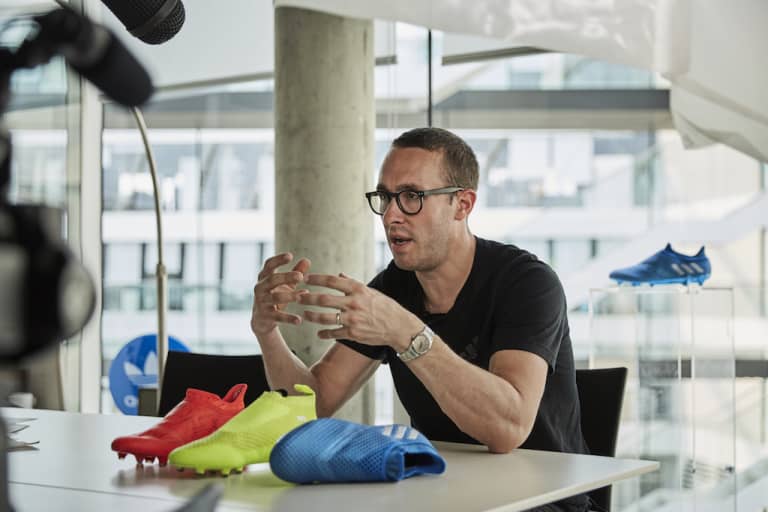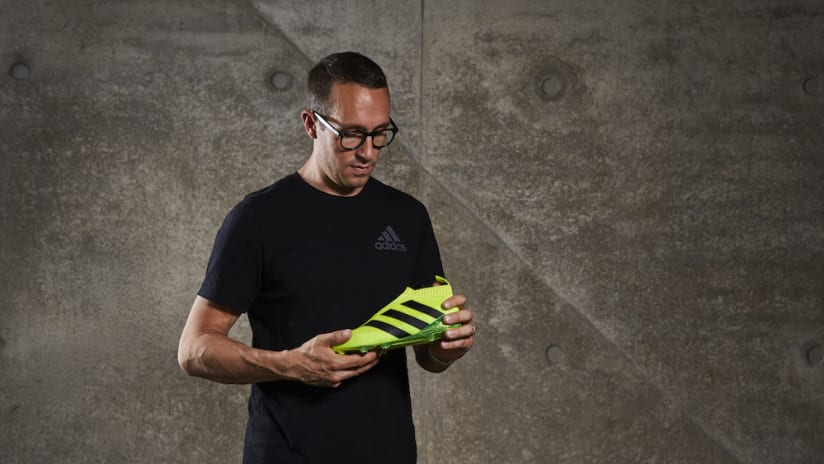If you basked in the bold blue, white, and red of the recent 2016 AT&T MLS All-Star game kits, you have one man to thank. That’s Sam Handy, the global VP of design for adidas Football for one year now. Beyond those jerseys, he’s probably touched the lion’s share of the latest soccer apparel and boots you know and love.
While he travels the world, he helps lead the charge to design innovative new soccer cleats for some of the world’s biggest stars, the kits that every MLS club wears, and much more. In other words, he helps run things for all of adidas’ soccer business, both on and off the field.
Mlssoccer.com recently had the chance to talk to Handy to find out what’s brewing with his team. Here’s what he had to say by phone from Germany about that, the intersection of performance and lifestyle, and where it’s all going in MLS.
You recently spent some time in the US and attended your first MLS game. What were your impressions of it?
Sam Handy: I saw the Timbers vs. Montreal in Portland – I thought it was proper football. It wasn’t what I was expecting. It was an amazing vibe; it was a proper football stand. The vibe from the fans was awesome and I thought the standard of play was fantastic.
All of that must have served in part as research for the upcoming 2018 MLS kits, which you are currently working on. Can you walk us through the design process of that? Where do you all start when designing kits?
It’s an interesting one, because we design for MLS a little bit differently than we do with European clubs, because of the way the league is set up. We try to have a harmonized approach and a design that works through all of the kits, but also allow the clubs to be as individual as possible within that certain framework.
It’s quite an interesting design process, and we try to find that link that makes them feel like adidas, but still allowing the club to have enough personality and point of difference that they express what their city stands for. There is also a lot more embroidery and detailing with MLS clubs.
What we are working on at the moment is finding the links between what we are building for the 2018 World Cup. [We’re working on] federation jerseys, like the German federation, and thinking about how that might influence some MLS clubs in spring 2018 as well.
It’s hard to talk about it without giving anything away, but that’s what we’re in the middle of at the moment; 2018 is a very big year for us. We’re also working on boots for 2018 that launch just before the World Cup, and then the fall 2018 boots that launch exactly at World Cup. This is a very busy time of year for football design.

Photo courtesy of adidas
That’s two years from now, so do you usually work on a two-year design cycle?
One of the things that we are seeing is that our design calendar is getting much, much shorter. As tastes continue to change, we’re getting closer to the moment when things get to market.
We have to be a little bit closer on some of our decision-making and be a bit more reactive to what is resonating with our soccer kid. What are they talking about? What products are they in love with? What musicians they are listening to? How does all this influence the products that we are making?
We end up working on quite a bit of the calendars at the same time. Our innovation calendar may be about five years out, whereas we work on something like color much more closer to when the product hits the market.
Or, we might also be working on stadium-to-street shoes like the Ace Laceless Ultra Boost sneakers that we just launched. That was built on a much shorter calendar than we would normally use.
Let’s talk quickly about that sneaker. It bridges performance and lifestyle beautifully. How did this come about?
This sneaker sold out in about a minute on a bunch of web sites, and I find it a bit hard to understate how important I think this shoe is. I think it’s the most important footwear project we’ve ever built, because it’s trying to stretch the boundaries of high performance categories and how they can become street wear products, without losing any of their performance credibility.
With the Pure Control Ultra Boost, it literally took the two best pillars of the brand, the best pillars in the industry, and together they made something bigger than the sum of their parts. It’s also going to really influence how the performance categories can work together doing bigger and better things together in the future.
What do you think is happening to the gap between performance and lifestyle?
I think it’s completely blurred right now. I think what’s important for brands like adidas is to retain why you are building products in the first place.
We’re definitely not trying to build fashion products when we build our football cleats. The principle of every boot that we make is to make the best players in the world even better. But the sensibility that we build them with starts to be much more influenced by youth culture in general. The influences of the aesthetics of our on-pitch creations get much more influenced by youth culture, by sneaker culture.
The reason that we build them, and the innovation that goes into the boots, will never go away. The function will get better and better, but the look is also going to become more relevant to off-pitch as we go forward.
When I think what we are doing from spring/summer 2017 that we are launching in December of this year, you will see a lot of that in the ranges. I think you see it in Ace Pure Control. It looks like a wicked sneaker with studs on it. You take the studs off and put it on Ultra Boost and it’s still a wicked sneaker.
How much do you see sneaker culture and music culture influencing your soccer designs going forward?
I think this is an amazing time for the sport. I think we see this intersection of youth culture, street culture and sport in many sports. You see it in running. You’ve seen it for a long time in basketball. You saw it with tennis in the 1990s.
But I think the way you are seeing it in soccer at the moment is really interesting. I think you’re seeing the bigger clubs getting bigger and bigger, and more important and turning into big global brands with huge reach.
You’re seeing players like Paul Pogba that are becoming as relevant to street culture as they are for their playing style. Athletes are as much of an icon as musicians are. They’re very influential off-pitch.
How does the growing soccer appetite in the US influence how you all plan and design product?
It definitely changes how we’re building product. In apparel, we start to put our silhouettes together more and more with how we think they are going to be re-appropriated later on.
That might mean building a high-performance piece that you can wear for the game that is more versatile. Or it might mean building five-a-side shoes knowing that a soccer kid is spending the whole day in the city in his five-a-side shoes. And we know that this sneaker also has to perform.
I think it feels like a time, especially in the US, where it’s really happening for soccer. I talk to young kids in the US. They know what’s going on in MLS. They know what the teams are. They know the different kit designs. They know who the players are.
Soccer is meaning something in the US that I don’t think it meant before. I also think this is really an interesting cultural shift. It’s a great time to be in MLS right now.










